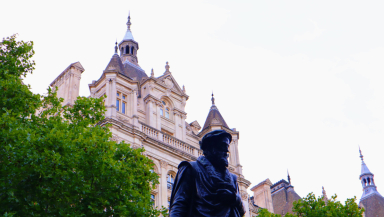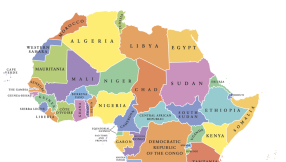
6th October is the day when William Tyndale is remembered. This is the story ...
Birthplace
William Tyndale was born in south Gloucestershire before the Reformation. There are different theories about where he was born but his family had connections with the villages of Stinchcombe, Dursley and North Nibley in the Cotswolds. We cannot be sure of the year he was born, but most likely it was in the early 1490s.
Tyndale grew up in the south Gloucestershire area not far from Bristol. Bristol was a busy port with merchants and traders and visitors from continental Europe. The area was known for Lollards who were England's first evangelical movement. They read the Bible in English, which had been translated by John Wycliffe and his followers at the end of the fourteenth century.
Archaic and translated from Latin, it was not ideal, but it was better than nothing. Tyndale was familiar with it, but dreamt of a better translation. English had changed a lot in the previous century and a half, and Erasmus had printed a Greek New Testament, compiled from available Byzantine Greek manuscripts. Now it was possible to translate from Greek into English. William Tyndale was a graduate of Oxford, an ordained priest, familiar with Latin and other languages, and a wordsmith in his own native English.
He became chaplain to Sir John Walsh and his family at Little Sodbury Manor about 1521, and it is probably here that he started to translate the New Testament from Greek into English.
Since 1408, the Constitutions of Oxford, issued by the bishops of England, had forbidden anyone to translate the Bible into English except with the permission of a bishop. So, Tyndale sought permission from the Bishop of London, who he had reason to believe would support his enterprise. However, he was proved wrong, and not only did his request get turned down, but he had now alerted the authorities to what he was doing. For this reason, in about 1524 he fled to Hamburg on the continent of Europe to continue his work.
1525 Cologne Fragment
He completed the New Testament in Cologne in Germany, but he was caught and his work was chucked unceremoniously into the River Rhine. It was probably published by Peter Quentel in Cologne in 1525, with the woodcut made by Anton von Worms. He rescued or somehow retained the first octave section which was smuggled into England, and in 1525 people were able to read his prologue. The prologue began 'I haue here translated (brethern and susters most dere and tenderly beloued in Christ) the newe Testament for youre spirituall edifyinge, consolacion and solas'.
This was followed by the first 22 chapters of Matthew which ends midway through verse eleven. It was a tantalising insight into what was lost. There is only one copy of the Cologne Fragment known to exist, which is kept in the Grenville Collection at the British Library. All that has survived is 31 pages which contain Tyndale's Prologue, the contents page, a woodcut of St Matthew, and chapters 1-22 of Matthew's Gospel including side notes and cross-references.
1525/6 New Testament
So William Tyndale moved down the River Rhine to Worms (later made famous by the Diet of Worms when Martin Luther was condemned as a heretic). He then started again and another printer remade his New Testament, this time without the copious notes which we find in his Cologne Fragment. These were smuggled into England and are noted as appearing in February 1525. This is confusingly now 1526 after the 1752 calendar reform when the year was changed to start on the 1st January instead of Lady Day, 25th March, so is often written 1525/6.
The 1526 first edition of William Tyndale's New Testament included a front panel, a table of contents called 'Bokes Conteyned in the newe Testament', the New Testament, and at the end were notes 'To the Reder', followed by Errata. The original 1525/6 New Testament includes the 27 books of the New Testament ordered according to the order of Luther's German Bible, which is not the usual order of English Bibles today. It included chapter numbers, but not verse numbers, which did not appear in English Bibles until the Geneva Bible.
Although these were printed, smuggled and read in the thousands, they were hunted down and burnt, and only a few copies survive. There is one in Stuttgart, a partial one in St Paul's Cathedral library in London, and the best known one is in the British Library. This was so important that the British Library paid over a million pounds for it 1994.
1530/1 Old Testament books
At some point in Germany, Tyndale learnt Hebrew, and set about translating the Old Testament from Hebrew to fulfil his dream of a complete Bible in English. First he completed the Pentateuch of the first five books i.e. Genesis, Exodus, Leviticus, Numbers and Deuteronomy, which he called "The fiue books of Moses'. He then produced 'The storie of the prophete Ionas' i.e. the book of Jonah, complete with prologue.
Imprints state that these were printed at Marburg in Hesse by Hans Luft on 17 January 1530 (now 1531). A copy of Tyndale's Jonah was found in 1861 and it became better known after the English Quaker Bible scholar, William Fry, reproduced it in facsimile in 1863.
Actually many scholars also believe Tyndale translated from Joshua through to 2 Chronicles, which were not published in his lifetime, but made their way into the Matthew Bible published in 1537. Certainly, in the Matthew Bible the Old Testament has the style of Tyndale up to the end of 2 Chronicles when the style changes to that of Coverdale. All the time while he was translating the Old Testament he was thinking about how to improve his New Testament. Tyndale had to move on again and settled in Antwerp in Flanders (now Belgium).
1534 New Testament
In 1534 William Tyndale produced his revised New Testament, which was an overhaul of his previous New Testament, complete with prologues. This New Testament was produced for both private reading and liturgical use. He marked up all the New Testament lectionary readings and added an appendix of the Old Testament lectionary readings. The lectionary then in use was the Salisbury or Sarum Rite lectionary, which was later the basis of the Book Common Prayer. An imprint states that this New Testament was printed by Martin Emperor in 1534.
Arrest
It is believed that about 18,000 copies of this New Testament had been printed and smuggled into England. William Tyndale was wanted by the authorities in England and in 1535, he was eventually betrayed while in Antwerp by an English 'Judas', and handed over to the authorities. He was imprisoned at Vilvoorde Castle, put on trial, and condemned for heresy.
He had not only translated much of the Bible but also produced other polemic and theological books, which were enough proof in print of his beliefs to condemn him. He was condemned not for translating the Bible, but for heresy, although this translation was perhaps the primary reason he was hunted down, and writing a book called 'The Practice of Prelates' which attacked Henry VIII's attempt to get a divorce did not help him either.
Death
He was burnt at the stake in Vilvoorde, Flanders. The exact date is not known but traditionally it is given as 6th October, 1536, and it was certainly about then. Had he not been martyred he would have wanted to complete the Old Testament, a work which was completed by his friends Miles Coverdale and John Rogers.
Tyndale's Legacy
The legacy of William Tyndale is that his translation ended up in the Matthew Bible, and this was edited by Miles Coverdale as the Great Bible which Henry VIII ordered be placed in every parish church in 1539. This was revised as the Bishops Bible under Queen Elizabeth I, which was in turn revised as the Authorized Version (AV) also known as the King James Version (KJV), by King James and published in 1611. This was the main Bible used in the English-speaking world for centuries until recently.
A revision of the KJV ordered by the Church of England and called the Revised Version (RV) was brought out in 1885. An American version of this was produced called the American Standard Version (ASV) in 1901. This was revised and called the Revised Standard Version (RSV) produced in 1952, which was the first modern translation to outsell the KJV.
More recently both the New Revised Standard Version (NRSV) and the English Standard Version (ESV) are revisions of the RSV. In other words, some of the most popular Bible translations into English today are revisions of revisions of revisions of Tyndale, certainly in the New Testament and the early Old Testament. In fact, if you take Tyndale's translations and put them into modernised spelling and punctuation, they are still readable and understandable, and if you compare it with RSV, NRSV and ESV in many places it is very similar and sometimes virtually identical.
Take John 3:16 as an example. It was Tyndale who first translated it into English as 'For God so loveth the world that he hath given his only son that none that believe in him should perish: but should have everlasting life'.
On 6 October take a moment to recall William Tyndale, who gave us the modern English Bible.













